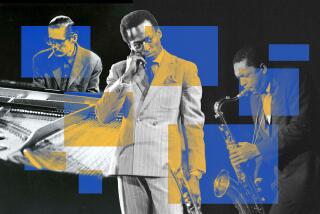Woody Shaw: Getting the Glow at Last
- Share via
The recently released “The Complete CBS Studio Recordings of Woody Shaw” on Mosaic Records, raises a serious question: Is Shaw the forgotten trumpet master of contemporary modern jazz?
Shaw, who died in 1989 at 45, was certainly the next major figure in the post-bop trumpet lineage that begins with Miles Davis and Clifford Brown, and includes such giants as Lee Morgan and Freddie Hubbard.
But Shaw, a superb artist who coupled technical precision and a dynamic harmonic approach with telling lyricism and a round, ringing sound, never got his well-deserved moment in the spotlight. His ascension to star stature in acoustic jazz unfortunately coincided with the nadir of the music’s popularity; from the early ‘70s until the early ‘80s and the arrival of Wynton Marsalis, traditional style jazz was all but an anathema.
The innovative trumpeter’s recording career as a leader spanned slightly more than a decade, and during that period he made numerous first-rate albums. Four of the best of these are collected on the three-CD Mosaic package, which feature tracks made between 1977 and 1981, and reveals Shaw at his creative zenith.
The set, which includes one previously unreleased take, features such Shaw compositions as the lulling “Rosewood” and the searing “To Kill a Brick,” and spotlights a stellar cast of musicians, pianists Mulgrew Miller and Onaje Allen Gumbs and saxophonists Carter Jefferson and Gary Bartz among them.
“The music that Woody produced on Columbia was of a high order. It needs to be out,” said Charlie Lourie, who co-owns Mosaic with Michael Cuscuna, the original producer of these dates for CBS. “Woody was such an extraordinary player and so painfully few people know that. Wynton Marsalis is out there making such a splash and Woody’s just not getting the glow from that and he should be.”
The Shaw box, priced at $45, is available by mail only from Mosaic Records, 35 Melrose Place, Stamford, Conn. 06902.
Norris Hits Town: Pianist Walter Norris, the diverse artist who plays unaccompanied tonight and Saturday at the Jazz Bakery in Culver City, and Oct. 17 at the Club Brasserie in West Hollywood, has been a witness to one of the most dramatic changes in Western Europe: the reunification of Germany.
Norris, who resided in Los Angeles from 1953 to 1960 but who has lived in Berlin since 1977, said Berlin “used to be this beautiful little town until the wall opened up and then it was flooded with people, which has been very exciting.”
“I thought it was fantastic,” said Norris, “but a lot of people thought it was very bad. It’s cost money and a lot of people have had to suffer.”
The pianist, who travels to his former Southland climes about once a year, said the pinch of the international economic decline is certainly felt in Germany, but that he takes that pinch in stride. “We in the arts are the first to feel the cutbacks, but these are just the times that we are going through. Still, people need music, they need art, they can work better when they have art.”
While in Los Angeles in 1958, Norris became part of jazz history, making a now-legendary recording, “Something Else,” on Contemporary Records, with the renowned experimenting saxophonist Ornette Coleman.
“Today that music doesn’t sound all that far out at all, but then I didn’t know what to think,” he said. “It had a few natural qualities that are a must in music, like Ornette’s sound. It was like he was crying into the horn, and this is something that touches people whether they know music or not. Art must have some natural elements that connect it with humanity.”
More to Read
The biggest entertainment stories
Get our big stories about Hollywood, film, television, music, arts, culture and more right in your inbox as soon as they publish.
You may occasionally receive promotional content from the Los Angeles Times.










